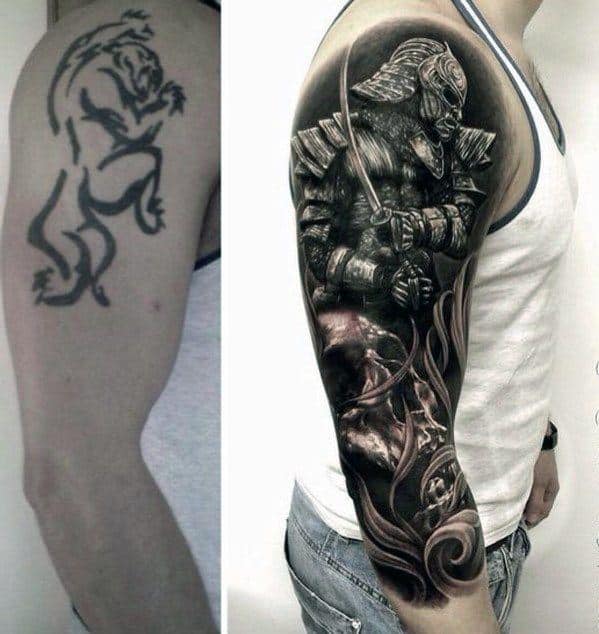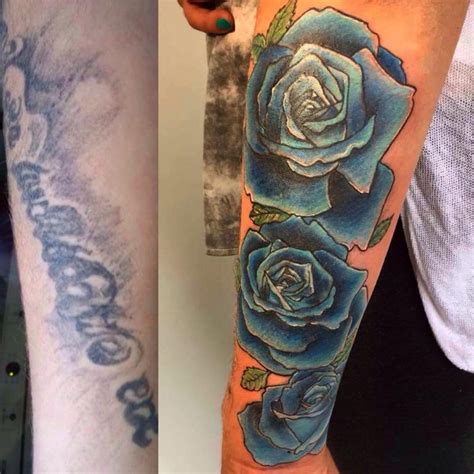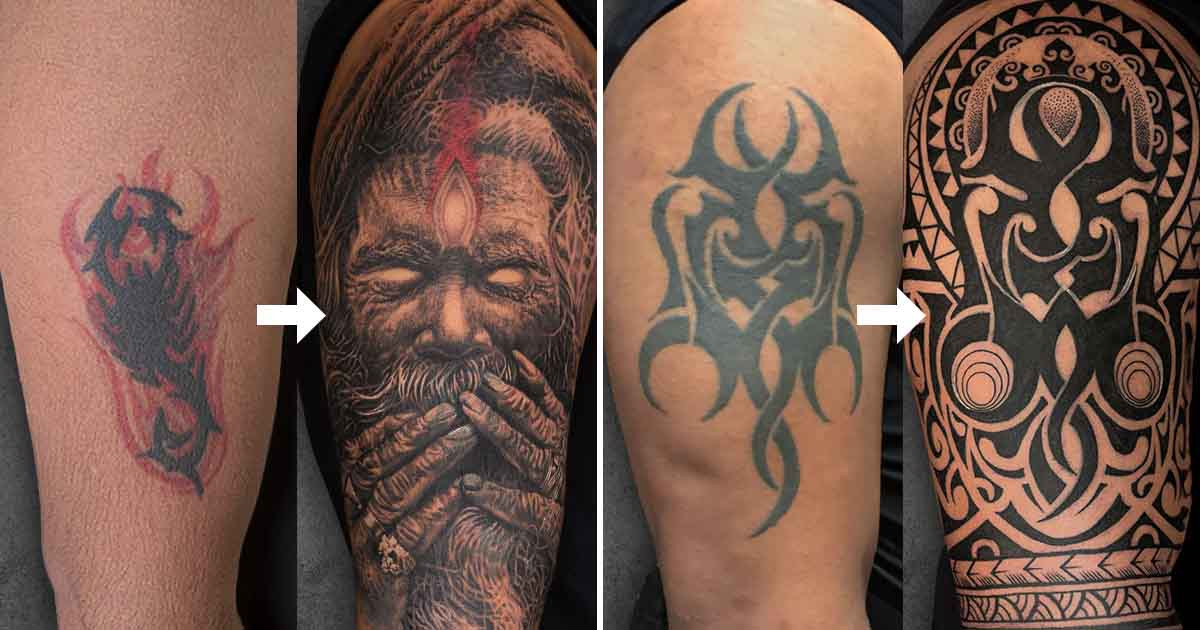Tattoos are a form of self-expression, a way to showcase one's personality, and a reflection of personal stories. However, as time passes and life evolves, some people find themselves wanting to cover up old tattoos for various reasons. Whether it's due to a change in taste, a desire to start anew, or a need to conceal a tattoo for professional or personal reasons, covering up tattoos has become a common practice. In this comprehensive guide, we will explore the art of transforming old tattoos into new masterpieces, delving into the techniques, patterns, and considerations that make this process an exciting journey of self-reinvention.
Understanding the Art of Cover-Up Tattoos

Cover-up tattoos are not merely about concealing an existing design; they are an opportunity to create something entirely new and meaningful. It requires a thoughtful approach, combining artistic skills with an understanding of tattoo removal techniques and the unique challenges posed by existing ink. Here, we unravel the intricacies of this captivating process.
The Science Behind Tattoo Cover-Ups
Covering up a tattoo involves a delicate dance between the original ink and the new design. The success of this transformation lies in understanding how tattoos work and how the skin heals. When a tattoo is covered up, the artist must consider the depth of the existing ink, the color palette, and the healing process of the skin to ensure the new tattoo takes hold effectively.
For instance, lighter colors like yellow, pink, and white are often more challenging to cover due to their proximity to the skin's natural tone. In contrast, darker inks, especially black, provide a better canvas for cover-ups as they can be effectively transformed into new designs.
| Tattoo Color | Cover-Up Feasibility |
|---|---|
| Black | High - Ideal for cover-ups due to its depth and contrast. |
| Dark Blues and Greens | Moderate - Can be covered effectively with the right technique. |
| Light Colors (Yellow, Pink, White) | Challenging - Requires skilled technique and careful consideration. |

Mastering the Art of Placement
The placement of a cover-up tattoo is crucial for achieving a seamless and aesthetically pleasing result. Artists must consider the shape, size, and contours of the existing tattoo, ensuring the new design complements the natural lines and curves of the body. This requires a keen eye for detail and an understanding of human anatomy.
For example, covering a small tattoo on the forearm might involve extending the new design to incorporate the entire arm, creating a cohesive and visually appealing piece. On the other hand, a large back piece might require a more intricate approach, breaking down the existing design into sections and transforming each part into a unique element of the new artwork.
Choosing the Perfect Cover-Up Pattern

The choice of pattern for a cover-up tattoo is a deeply personal decision. It’s not just about aesthetics; it’s about telling a new story and expressing a new chapter in life. Here, we explore a range of popular cover-up patterns and the unique narratives they can help create.
Floral Patterns: A Touch of Nature’s Beauty
Floral patterns are a popular choice for cover-ups, offering a delicate and aesthetically pleasing transformation. From intricate rose bouquets to wildflower meadows, these designs bring a touch of nature’s beauty to the skin. They are particularly effective in covering up small to medium-sized tattoos, adding a soft and romantic element to the body art.
Consider the story behind the original tattoo. Perhaps it was a symbol of a past relationship or a reminder of a specific time in life. By covering it with a floral pattern, the individual can transform the narrative, symbolizing growth, renewal, and the beauty that can emerge from challenging experiences.
Abstract and Geometric Designs: A Modern Twist
For those seeking a more contemporary and unique approach, abstract and geometric designs offer an exciting avenue for cover-ups. These patterns play with lines, shapes, and colors, creating visually captivating pieces that stand out. They are particularly effective in covering up tattoos with complex or intricate details, offering a modern twist to the original design.
An abstract cover-up might involve transforming a detailed portrait into a series of interconnected shapes, symbolizing the interconnectedness of life experiences. Or, it could be a way to represent the abstract concepts that define an individual's philosophy or beliefs.
Animal Motifs: Bringing Life and Movement
Animal motifs are powerful symbols in the world of tattoos, often representing strength, freedom, and a connection to nature. Covering up a tattoo with an animal design can be a dynamic way to transform the original piece, bringing a sense of movement and vitality to the skin.
Imagine covering a simple tattoo of a bird with a detailed eagle in flight. The new design not only adds depth and detail but also symbolizes the freedom and power that the individual wishes to embody in their new chapter.
The Process of Covering Up Tattoos
Covering up a tattoo is a meticulous process that requires skilled artistry and a deep understanding of the skin. It involves a series of steps, each critical to the success of the transformation. Here, we break down the process, shedding light on the expertise and techniques involved.
Consultation and Planning
The journey begins with a consultation, where the individual and the tattoo artist discuss the goals, challenges, and desired outcome. This is a crucial step, as it allows the artist to understand the client’s vision and provide expert guidance based on the existing tattoo and the skin’s characteristics.
During this phase, the artist will assess the size, color, and depth of the existing tattoo, offering suggestions and sketches to bring the new design to life. It's a collaborative process, ensuring that the final result aligns with the individual's expectations and personal narrative.
Tattoo Removal Techniques
In some cases, especially for larger or more intricate tattoos, the artist might recommend a tattoo removal process before proceeding with the cover-up. This can involve laser tattoo removal, a method that breaks down the ink particles, making them easier to cover up and transform.
Laser tattoo removal is a gradual process, typically requiring multiple sessions to achieve the desired results. The artist will work closely with the individual, ensuring the skin heals properly between sessions and the cover-up design is ready to be applied.
The Art of Transformation
With the planning and, if necessary, the removal process complete, it’s time for the transformation. The artist carefully applies the new design, considering the placement, size, and details to ensure a seamless and visually appealing result. This step requires precision, creativity, and an artistic eye to bring the new tattoo to life.
The individual might opt for a session of touch-ups after the initial cover-up to refine the design, ensuring it meets their expectations. This process showcases the artist's dedication to perfection and the individual's commitment to their new self-expression.
Inspiring Cover-Up Tattoo Stories
The world of cover-up tattoos is filled with inspiring stories of transformation and self-reinvention. Here, we share a few real-life examples that showcase the power of this art form and the profound impact it can have on individuals’ lives.
From Old School to New School: A Modern Makeover
John, a 40-year-old businessman, had a large, colorful old school tattoo on his back, a remnant of his youthful days. As he progressed in his career, he felt the tattoo was no longer aligned with his professional image. He decided to undergo a cover-up process, transforming the vibrant old school design into a sleek and modern new school piece.
The new tattoo, a detailed black and grey piece, depicted a powerful wolf, symbolizing strength and leadership. The transformation not only enhanced John's professional image but also gave him a sense of renewed confidence, reflecting his growth and maturity.
Healing Through Art: Covering Up Trauma Tattoos
For some individuals, tattoos can be a reminder of traumatic experiences. Covering up these tattoos can be a powerful form of healing, transforming pain into beauty and empowerment. Sarah, a survivor of domestic violence, had a tattoo that served as a constant reminder of her past trauma.
Through the art of cover-ups, Sarah transformed her tattoo into a vibrant, colorful piece, depicting a phoenix rising from the ashes. The new design not only covered up the old tattoo but also symbolized her resilience and strength, serving as a daily reminder of her journey towards healing and empowerment.
Future Implications and Considerations

As the art of cover-up tattoos continues to evolve, it opens up new avenues for self-expression and personal growth. Here, we explore some future trends and considerations in this captivating realm of tattoo artistry.
Sustainability and Eco-Friendly Inks
With a growing focus on sustainability, the tattoo industry is also exploring eco-friendly options. This includes the development of natural inks derived from plant-based sources, offering a more sustainable alternative to traditional inks. These inks not only reduce the environmental impact but also provide a unique, organic aesthetic to cover-up tattoos.
Imagine a cover-up design that incorporates natural, earth-toned inks, creating a harmonious blend with the skin and the environment. This approach not only enhances the aesthetic appeal but also aligns with the values of sustainability and eco-consciousness.
Digital Tattoo Design: Precision and Personalization
Advancements in technology are revolutionizing the tattoo design process. Digital tattoo design platforms allow individuals to collaborate with artists remotely, creating personalized designs with precision and ease. This technology facilitates a more efficient cover-up process, ensuring the new design aligns perfectly with the individual’s vision.
With digital design, individuals can visualize their cover-up tattoos before the actual process, making informed decisions and ensuring a satisfying result. This technology-driven approach adds a new dimension to the art of tattoo cover-ups, enhancing the overall experience and outcome.
The Role of Social Media in Cover-Up Inspiration
Social media platforms have become a powerful tool for tattoo artists and enthusiasts alike, offering a platform to showcase and discover inspiring cover-up designs. Hashtags like #tattoocoverup and #tattootransformation have gained popularity, providing a space for individuals to share their journeys and seek inspiration.
For those considering a cover-up, exploring these online communities can offer a wealth of ideas and encouragement. It provides a sense of community, connecting individuals with similar experiences and allowing them to share their stories and support one another through the process of self-reinvention.
How long does the cover-up tattoo process typically take?
+The duration of the cover-up tattoo process can vary depending on the size and complexity of the existing tattoo and the desired new design. Typically, it can range from a few hours for smaller tattoos to multiple sessions spread over several weeks for larger, more intricate pieces. The artist will provide an estimated timeline during the initial consultation.
Is it possible to cover up a tattoo with a completely different style or theme?
+Absolutely! One of the beautiful aspects of cover-up tattoos is the opportunity to transform the existing design into something entirely new. Whether it’s changing from a realistic portrait to an abstract design or from a traditional piece to a modern one, skilled artists can create unique and personalized cover-ups that align with your vision.
Are there any limitations to what can be covered up with tattoos?
+While cover-up tattoos offer a wide range of possibilities, there are some considerations. The depth and color of the existing tattoo can influence the cover-up process. Lighter colors and intricate details might require more layers of ink, and very dark or dense tattoos might not be fully covered in a single session. A consultation with an experienced artist will help assess the feasibility and provide realistic expectations.